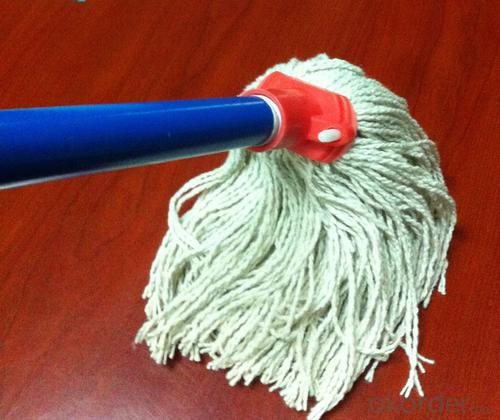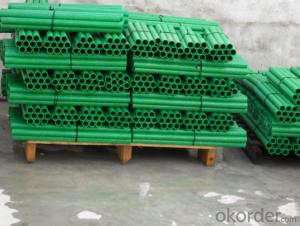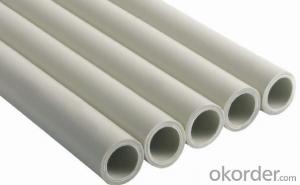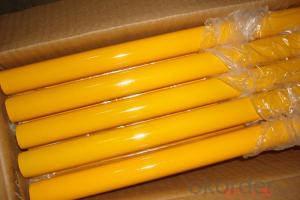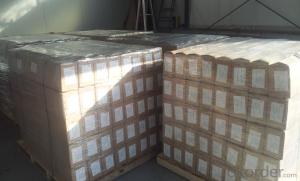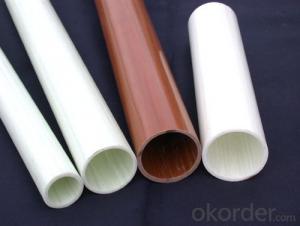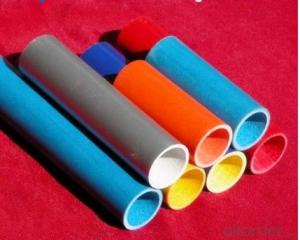FRP Pultrusion Profiles Fiberglass Broom Handle for Cleaning Industry
- Loading Port:
- China Main Port
- Payment Terms:
- TT OR LC
- Min Order Qty:
- -
- Supply Capability:
- -
OKorder Service Pledge
Quality Product, Order Online Tracking, Timely Delivery
OKorder Financial Service
Credit Rating, Credit Services, Credit Purchasing
You Might Also Like
Specifications of Fiberglass Broom Handle for Cleaning Industry:
Material : fiberglass
Feature: high strength, light weight, anti-aging
Description of Fiberglass Broom Handle for Cleaning Industry:
FRP/fiberglass Tool handles uses high-strength fiberglass as reinforcing material, thermosetting resin as the base and then taken shape on a special mold, where the high temperature activates the resin to cure. It provides properties such as: light in weight, high strength, anti-aging & beautiful appearance, and is widely used in the gardening tool industry as a fiberglass handle, it is an ideal substitute for wooden handle, iron handle and aluminum handle.
Product Performance of Fiberglass Broom Handle for Cleaning Industry:
* Light weight
* High strength
* Anti-aging
* Anticorrosion
* Beautiful, many kinds color
* Environment friendliness
Size of Fiberglass Broom Handle for Cleaning Industry:
OD32.3*ID26; OD32.3*ID27.5; OD32.3*ID28; OD32*ID26;OD32*ID27.5; OD32*ID28; OD30*ID26; OD30*ID24;OD25.4*ID20.5; OD24*ID20; OD22*ID18.4
- Q: Are FRP pultrusion profiles resistant to moisture or humidity?
- FRP pultrusion profiles boast exceptional resistance to moisture and humidity. Through the pultrusion process, continuous fibers are thoroughly saturated with a polymer resin, resulting in a steadfast and enduring composite material. This composite possesses inherent moisture resistance, differing from conventional materials like wood or metal, as it does not absorb water. Moreover, FRP pultrusion profiles exhibit a minimal coefficient of thermal expansion, minimizing the likelihood of expansion or contraction in response to varying humidity levels. This moisture and humidity resistance render FRP pultrusion profiles suitable for a diverse array of applications, including outdoor structures, marine environments, and other areas prone to moisture.
- Q: Are FRP pultrusion profiles resistant to chemical spills or leaks?
- FRP pultrusion profiles are known for their high resistance to chemical spills or leaks, making them an excellent choice for construction projects. One of the main benefits of using FRP as a building material is its exceptional chemical resistance. These profiles are made by impregnating continuous fibers with a thermosetting resin, resulting in a durable composite material. The selection of the resin used in FRP pultrusion profiles depends on the specific chemical environment they will be exposed to. This allows for customization and optimization of the composite's ability to withstand different chemicals. Additionally, the fibers used in FRP are typically chemically inert, further enhancing the profiles' resistance to chemical spills or leaks. FRP pultrusion profiles have proven to be highly resistant to a wide range of chemicals, including acids, alkalis, solvents, and corrosive substances. They are commonly used in industries such as chemical processing, water and wastewater treatment, oil and gas, and marine applications, where exposure to aggressive chemicals is common. Apart from their chemical resistance, FRP pultrusion profiles offer several other advantages. They are lightweight yet strong and stiff, making them ideal for applications that require structural integrity. They are also non-conductive, non-magnetic, and have excellent electrical insulation properties. Overall, FRP pultrusion profiles are a reliable option for environments where chemical spills or leaks are a concern. They provide robust resistance to a wide variety of chemicals, ensuring long-lasting performance and minimal maintenance requirements.
- Q: How do FRP pultrusion profiles perform in heavy-load applications?
- FRP (Fiber Reinforced Polymer) pultrusion profiles are known for their exceptional performance in heavy-load applications. Due to their high strength-to-weight ratio, these profiles can withstand substantial loads without compromising structural integrity. The pultrusion process ensures that the fibers are uniformly distributed and aligned along the length of the profile, resulting in superior strength and stiffness. In heavy-load applications, FRP pultrusion profiles exhibit excellent load-bearing capabilities. They have a high modulus of elasticity, meaning they can resist deformation under heavy loads, ensuring long-term durability. These profiles also have a high ultimate tensile strength, allowing them to withstand extreme forces without breaking or deforming. Furthermore, FRP pultrusion profiles are corrosion-resistant, making them ideal for heavy-load applications in harsh environments. Unlike traditional materials like steel, FRP does not rust or corrode, ensuring a longer lifespan and reduced maintenance costs. Another advantage of FRP pultrusion profiles in heavy-load applications is their electrical insulation properties. They do not conduct electricity, making them suitable for environments where electrical conductivity is a concern. Additionally, FRP pultrusion profiles are lightweight compared to traditional materials like steel or concrete. This characteristic not only simplifies transportation and installation but also reduces overall project costs. In summary, FRP pultrusion profiles perform exceptionally well in heavy-load applications. Their high strength-to-weight ratio, excellent load-bearing capabilities, corrosion resistance, electrical insulation properties, and lightweight nature make them a preferred choice for various industries, including construction, infrastructure, marine, and transportation.
- Q: Can FRP pultrusion profiles be used in wastewater treatment facilities?
- Yes, FRP (Fiber Reinforced Polymer) pultrusion profiles can be used in wastewater treatment facilities. FRP pultrusion profiles offer several advantages such as high strength-to-weight ratio, corrosion resistance, and durability, which make them suitable for use in harsh environments like wastewater treatment facilities. In wastewater treatment facilities, there are various applications where FRP pultrusion profiles can be used. These include but are not limited to walkways, handrails, ladders, grating, and structural supports. The corrosion resistance of FRP makes it ideal for use in areas exposed to moisture and chemicals present in wastewater. Furthermore, FRP profiles are lightweight, which simplifies installation and reduces the load on supporting structures. The durability of FRP pultrusion profiles ensures long-term performance, even in aggressive environments. They have a high resistance to chemical attack, UV radiation, and bacterial growth, making them suitable for wastewater treatment applications. Additionally, FRP profiles can be designed to meet specific load requirements and can be easily fabricated to fit various shapes and sizes. Moreover, FRP pultrusion profiles offer excellent electrical insulation properties, which can be advantageous in wastewater treatment facilities where electrical safety is a concern. In summary, FRP pultrusion profiles can be effectively used in wastewater treatment facilities due to their corrosion resistance, durability, lightweight nature, and versatility in design and fabrication. These profiles can provide long-lasting solutions for various applications within these facilities, ensuring operational efficiency and minimizing maintenance requirements.
- Q: Will the FRP section crack for a long time?
- Under normal circumstances, glass fiber reinforced plastic profiles will not appear cracking phenomenon, if there is cracking phenomenon, may be the following reasons:1, the placement method is incorrect, such as irregular, non closed section of a large number of stacked2 、 the resin content in the profile is low, filling is more (see if the section color is whiter, and more powder fall off at the same time)
- Q: How do FRP pultrusion profiles perform in high-humidity environments?
- FRP (Fiber Reinforced Polymer) pultrusion profiles are known for their excellent performance in high-humidity environments. The combination of the reinforced fibers and polymer matrix in FRP profiles makes them highly resistant to the detrimental effects of moisture and humidity. One of the key advantages of FRP materials is their inherent resistance to corrosion, which is especially crucial in high-humidity environments where moisture content is significantly higher. Unlike traditional materials such as steel or wood, FRP pultrusion profiles do not rust, rot, or decay when exposed to moisture. This makes them well-suited for various applications where constant exposure to humidity is expected, such as in coastal areas or industrial settings. Additionally, the polymer matrix used in FRP profiles acts as a barrier against moisture absorption. This prevents the profiles from expanding, warping, or cracking, even in extreme humidity conditions. The high-strength fibers embedded in the polymer matrix provide additional reinforcement, ensuring the profiles retain their structural integrity and dimensional stability over time. Furthermore, FRP pultrusion profiles are also resistant to mold and mildew growth, which are commonly associated with high-humidity environments. This feature is highly beneficial, as it reduces the need for frequent maintenance and cleaning, making FRP profiles a cost-effective and low-maintenance solution. In conclusion, FRP pultrusion profiles exhibit exceptional performance in high-humidity environments. Their resistance to corrosion, moisture absorption, and mold growth make them a reliable choice for applications that require durability and longevity in such conditions.
- Q: Are FRP pultrusion profiles electrically conductive?
- No, FRP pultrusion profiles are not electrically conductive.
- Q: How do FRP pultrusion profiles perform in high humidity environments?
- FRP pultrusion profiles perform exceptionally well in high humidity environments. The fiberglass reinforcement in the profiles provides excellent resistance to moisture absorption, preventing any adverse effects on their structural integrity. This makes them highly durable and suitable for long-term use in humid conditions without any significant degradation or damage.
- Q: Are FRP pultrusion profiles resistant to impact and vibration?
- FRP pultrusion profiles possess a high level of resistance to impact and vibration, thanks to their composition and manufacturing process. These profiles are inherently durable and strong due to the combination of resins and fibers used. The fibers, commonly glass or carbon, contribute to their excellent tensile strength, while the resin matrix adds toughness and impact resistance. The unique composition of FRP pultrusion profiles allows them to absorb energy effectively, enabling them to withstand impacts without significant deformation or damage. This quality makes them well-suited for applications that necessitate impact resistance, such as construction, transportation, and infrastructure projects. Furthermore, FRP pultrusion profiles exhibit exceptional vibration resistance. The composite material's inherent damping characteristics help disperse and dampen vibrations, minimizing the risk of structural fatigue and increasing the profiles' lifespan. This makes them ideal for use in environments with heightened vibration levels, including industrial machinery, bridges, and marine structures. Nevertheless, it is crucial to consider that the impact and vibration resistance of FRP pultrusion profiles may vary based on factors such as resin type, reinforcement fibers, and profile design. Thus, it is advisable to consult the manufacturer or supplier to ensure that the chosen FRP pultrusion profiles fulfill the specific impact and vibration resistance requirements of the intended application.
- Q: Are FRP pultrusion profiles resistant to UV degradation?
- Yes, FRP pultrusion profiles are generally resistant to UV degradation. The combination of the materials used in pultrusion, such as fiberglass and resin, provides inherent UV resistance, making them suitable for outdoor applications where exposure to sunlight is a concern. However, it is always recommended to consult the manufacturer's specifications and guidelines to ensure optimal UV protection and longevity.
Send your message to us
FRP Pultrusion Profiles Fiberglass Broom Handle for Cleaning Industry
- Loading Port:
- China Main Port
- Payment Terms:
- TT OR LC
- Min Order Qty:
- -
- Supply Capability:
- -
OKorder Service Pledge
Quality Product, Order Online Tracking, Timely Delivery
OKorder Financial Service
Credit Rating, Credit Services, Credit Purchasing
Similar products
Hot products
Hot Searches
Related keywords



